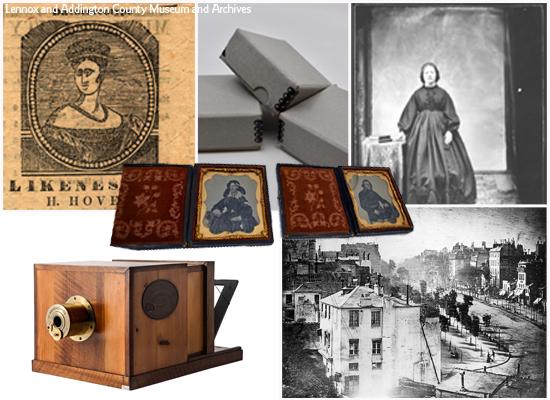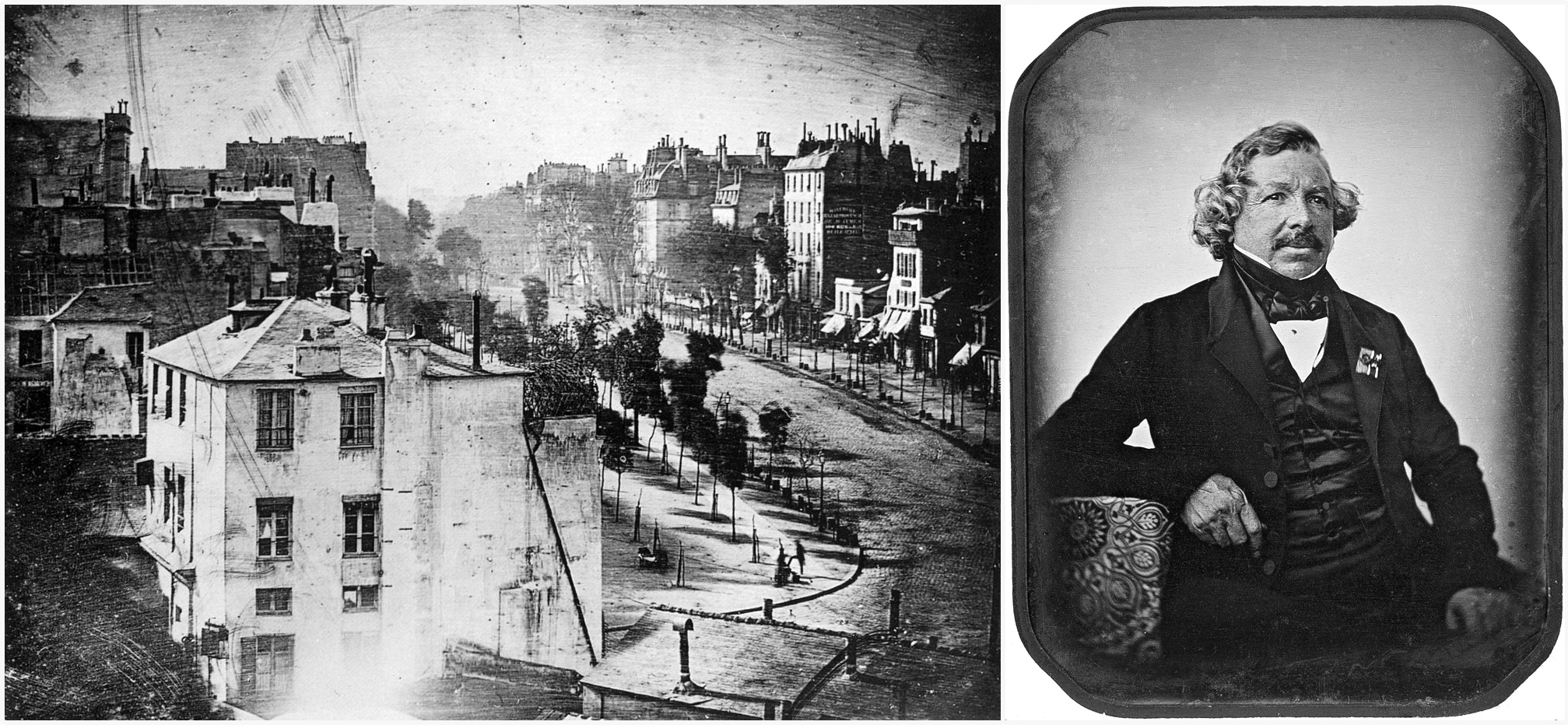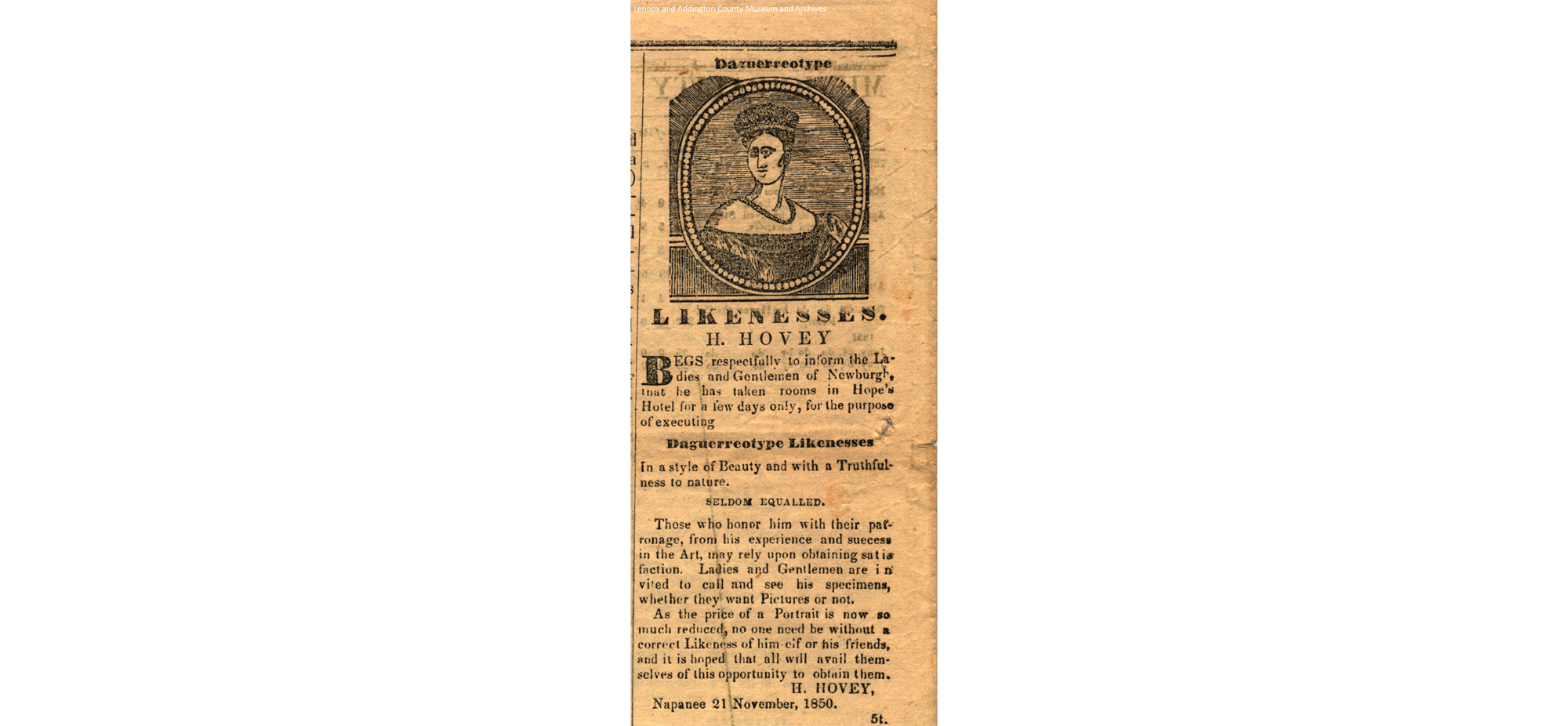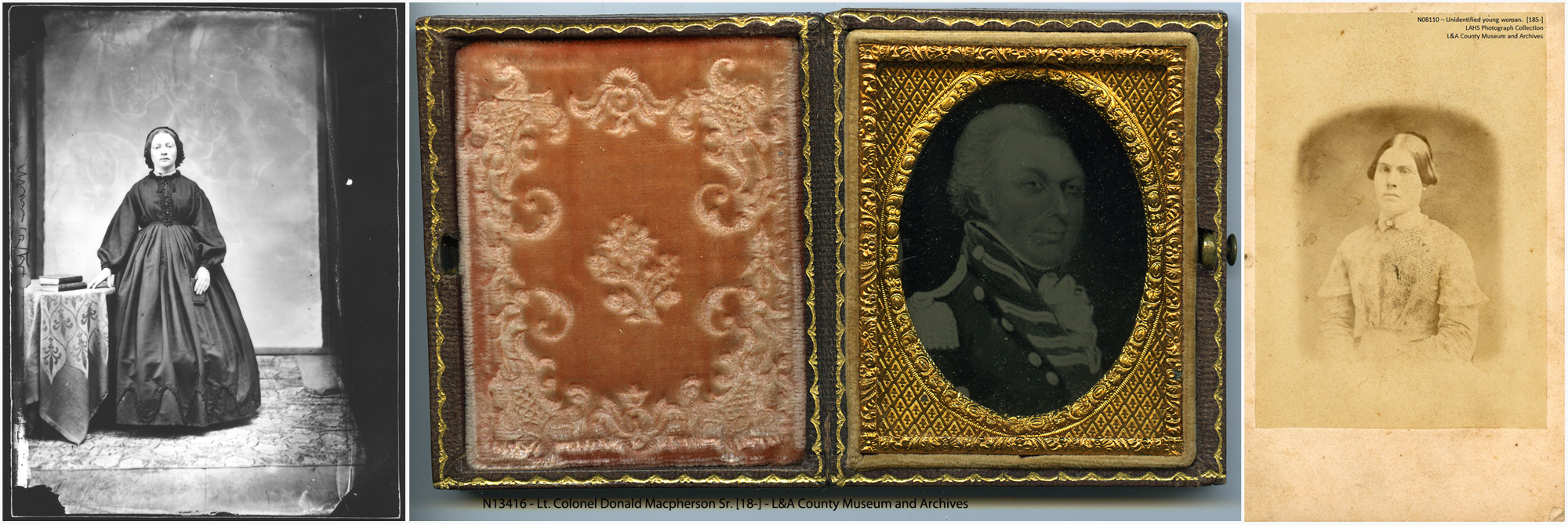
165-Year-Old Photographs in a Digital World
New Accessions at the Archives
The warmer months are a busy time at the Lennox and Addington County Museum and Archives. In between research requests and archival record processing, I try to find small passion projects to create access to parts of the archival collection that aren’t regularly accessed by researchers. This month, I decided to highlight ambrotypes and daguerreotypes since it is the 180th anniversary of the invention of the daguerreotype which revolutionized the history of photography.
A recent donation (A2019.030) of two ambrotype photographs inspired me to document the preservation process of daguerreotypes (1839 – 1860), ambrotypes (1854 – 1860) and tintypes (1856 – 1900) and show how we provide description of images to researchers.1
Daguerreotype refers to photographic technology that was invented by Louis-Jacques-Mandé Daguerre and first introduced to the public in 1839.2 The daguerreotype was one of the earliest photographic techniques to be used world wide and was used for over twenty years until it was succeeded by the collodion wet plate process and ambrotypes.3 Daguerreotypes created an international frenzy and people across Europe and North America rushed to line up to have their photograph taken for the first time.

Left – “‘Boulevard du Temple’, taken by Daguerre in 1838 in Paris, includes the earliest known candid photograph of a person. The image shows a busy street, but because the exposure had to continue for several minutes the moving traffic is not visible. At the lower right, however, a man apparently having his boots polished, and the person polishing them, were motionless enough for their images to be captured.”
Right – Portrait of Louis Daguerre (1787-1851) who invented the daguerreotype by Jean-Baptiste Sabatier-Blot, Public Domain
Below is an advertisement from the Napanee Bee Newspaper from November 21st, 1850 that highlights a photographer’s visit to take daguerreotype photographs for the residents of Newburgh. The advertisements states: “H. Hovey begs respectfully to inform the Ladies and Gentlemen of Newburgh that he has taken rooms in Hope’s Hotel for a few days only, for the purpose of executing daguerreotype likeness in a style of beauty and with a truth to nature.” One can only imagine the excitement the residents of Newburgh must have experienced reading that advisement in the local newspaper!

Napanee Bee Newspaper, November 21st, 1850, Lennox and Addington County Museum and Archives
Daguerreotypes were created on a reflective mirror surface made on silver-plated copper, exposed to mercury then chemically treated to create an image that appears positive or negative depending on how you view the photograph.4 Daguerreotypes were succeeded by ambrotype technology in the 1850’s since new technology was cheaper and more efficient to use.5 “Surfaces of daguerreotypes are extremely fragile and should never be touched; the image can be removed or permanently damaged with the touch of a fine cloth or brush. Daguerreotypes are easily recognized by their mirror-like surface, and a magnet can be used to distinguish tintypes from ambrotypes.”6

Left – N-02577 – Unidentified woman holding a daguerreotype case, March 10th, 1864 by Stephen Manson Benson (1836-1901), wet collodion negative, Lennox and Addington County Museum and Archives
Centre – N-13416 – Portrait of Lt. Colonel Donald Macpherson Sr., [184-], daguerreotype, Lennox and Addington County Museum and Archives
Right – N-08110 – Unidentified young woman, later copy of a daguerreotype, [185-], Lennox and Addington County Museum and Archives
Daguerreotypes were commonly used to create copy prints of photographs
An ambrotype “is essentially a glass negative with a black background that makes the image appear positive. It is a cased photograph and was invented about 1854, the form lost popularity in the early 1860’s when tintypes and card mounted paper prints replaced it”.7
The donation of ambrotypes (A2019.030 – please see below) sparked my interest in researching the history of ambrotype photographs. What is unique about these ambrotypes is the family connection to the Weese family. “Old photographs have aesthetic and historical value and when they are family photos, there is also nostalgic and sentimental appeal. But sometimes those pictures are not properly identified, which greatly limits their value both as historical objects and as family mementos. One step that goes a long way towards properly identifying a photograph is to establish the date, at least approximately, when it was taken.” 8

2019.030.2 and 2019.030.3
Ambrotypes of [Elizabeth Howell and William Weese Jr.], [185-], 7 x 9cm, Lennox and Addington County Museum and Archives
It is believed that the two photographs are of [Elizabeth Howell] and her husband [William Weese Jr.] based upon the date of the ambrotypes and genealogical research by the donor. “Legend has it that the Weese family is descended from an old German family. The first recorded member was an old ocean pirate named William, from along the Weser River in the 1600’s. The name originally spelled Wees means orphan or child needing care. In Canada the original founder of the [Weese] family signed his name John Wees. He is on army lists as Wist, Wuist and West.”9
For more information about Weese genealogy or help with your genealogy please contact the Archivist or check out our online database!

Left – Archival boxes for long term storage of ambrotypes and daguerreotypes
Centre – 2019.030.2 – Ambrotype of [Elizabeth Howell], [185-], 7 x 9cm, Lennox and Addington County Museum and Archives
Right – Ambrotype cover of 2019.030.2 and an archival storage box
Ambrotypes and daguerreotypes pose separate conservation concerns. Due to the fragility of the emulsion on the glass and metal plates it is vital that the photographs be handled as little as possible. The photographic surface can be easily rubbed off due to handling, environmental conditions or sensitivity to light overtime. This is evident in the detail of the ambrotype of Elizabeth Howell [2019.030.2] where you can see the emulsion coming off of the glass. In addition to the glass or metal plate needing special conservation attention, the decorative boxes that house ambrotype photographs also pose their own concerns. Cases that are in poor condition “should be wrapped individually and placed flat in a shallow drawer or flat document box”.10 Many conservators suggest to take a photograph of the ambrotype or daguerreotype and place it on the outside of the archival box so it is easy to identify photographs to reduce handling of the original archival record.11
19th century glass that accompanies daguerreotypes, ambrotypes and glass plate negatives is relatively unstable.12 As mentioned earlier, the image on the surface of glass can easily be removed and it is recommended that no glass cleaners be used to clean early photographs.13 Daguerreotypes and ambrotypes should be kept in low relative humidity, exposed to as little light as possible, checked periodically for any changes in preservation status and “stored face down to slow down deterioration” of the original image.14
Once I accession the ambrotypes into our database and prepare the housing materials for the photographs, I will create a copy photograph of the ambrotypes to add to the label of the box for easy identification which will help to reduce wear and tear on the original record. Creating intellectual control of the photograph (i.e. detailed metadata for discoverability and digitization of the image) is the most important factor for ensuring long term preservation for future access of 19th century photographs like daguerreotypes and ambrotypes.15
Included in the 2019.030 donation was a book of poetry written by Wilbert Weese who lived in Lennox and Addington County in the 19th century. The book of poetry dates from 1894 – 1895. “Wilbert Weese received his education at Albert College in Belleville and became a teacher and later a Minister of the Methodist Episcopal Church.”16 For more information about the connection of Wilbert Weese, the Weese family and the ambrotype photographs of members of the Weese family, please contact the Archivist!

Left – Detail of ambrotype of [William Weese Jr.], [185-], 7 x 9cm, Lennox and Addington County Museum and Archives
Centre – 2019.030.1 – Poetry by Wilbert Weese, 1894 – 1895, 2cm textual record, Lennox and Addington County Museum and Archives
Right – Detail of ambrotype of [Elizabeth Howell], [185-], 7 x 9cm, Lennox and Addington County Museum and Archives
Providing access to historical records is my favourite part of being an Archivist. Whether it’s through uploading descriptions to a database, creating metadata for digitally born records, digitizing 19th century photographs or helping researchers access textual records at the Lennox and Addington County Museum and Archives, I enjoy helping researchers access information. Creating digital access to historical records gives records a digital legacy and allows users to interact with history in a new way. Digitizing and preserving the 165-year-old ambrotype photographs will ensure long term access that will help with genealogical and historical research.
“Technology has long brought enormous benefits, along with profound changes, to almost every aspect of human life. Much as the printing press revolutionized society starting in the 15th century, the digital revolution has had, and will continue to have, an enormous impact on daily life. Business, communications, entertainment, transportation, banking, education, health care, our interpersonal interactions and our physical movements — almost every aspect of our lives is mediated by digital technology.”17
I hope to continue to provide digital connections between historical records and research through processing collections for our Past Perfect online database and determining which records will be candidates for digitization projects. I look forward to using new tools and digitization workflows to create digital connections with history.
If you have any suggestions for archival photographs, books, textual records or maps you would like to see digitized on our database let us know!
Citations
1. Page 3, Dating Old Photographs, Halvor Moorshead and Jeff Chapman, Family Chronicle Publication, 2000.
2. Page 238, Photographs: Archival Care and Management, Mary Lynn Ritzenthaler, 2006.
3. Page 238, Photographs: Archival Care and Management, Mary Lynn Ritzenthaler, 2006.
4. Page 3, Dating Old Photographs, Halvor Moorshead and Jeff Chapman, Family Chronicle Publication, 2000.
5. Page 3, Dating Old Photographs, Halvor Moorshead and Jeff Chapman, Family Chronicle Publication, 2000.
6. Page 242, Photographs: Archival Care and Management, Mary Lynn Ritzenthaler, 2006.
7. Page 3, Dating Old Photographs, Halvor Moorshead and Jeff Chapman, Family Chronicle Publication, 2000.
8. Page 3, Dating Old Photographs, Halvor Moorshead and Jeff Chapman, Family Chronicle Publication, 2000.
9. Page 11, Roots and Branches, Prepared for the Weese Reunion, Grace Street, 1978.
10. Page 238, Photographs: Archival Care and Management, Mary Lynn Ritzenthaler, 2006.
11. Page 238, Photographs: Archival Care and Management, Mary Lynn Ritzenthaler, 2006.
12. Page 241, Photographs: Archival Care and Management, Mary Lynn Ritzenthaler, 2006.
13. Page 2421, Photographs: Archival Care and Management, Mary Lynn Ritzenthaler, 2006.
14. Page 241, Photographs: Archival Care and Management, Mary Lynn Ritzenthaler, 2006.
15. Page 230, Photographs: Archival Care and Management, Mary Lynn Ritzenthaler, 2006.
16. Page 20, Roots and Branches, Prepared for the Weese Reunion, Grace Street, 1978.
17. Strengthening Privacy for the Digital Age, Innovation, Science and Economic Development Canada, 2019.
References
Dating Old Photographs, Halvor Moorshead and Jeff Chapman, Family Chronicle Publication, 2000.
Roots and Branches, Prepared for the Weese Reunion, Grace Street, 1978.
Photographs: Archival Care and Management, Mary Lynn Ritzenthaler, 2006.
Strengthening Privacy for the Digital Age, Innovation, Science and Economic Development Canada, 2019 - https://www.ic.gc.ca/eic/site/062.nsf/eng/h_00107.html
Cover Image
Napanee Bee Newspaper, November 20th, 1850, Lennox and Addington County Museum and Archives
Daguerreotype camera – http://www.fotovoyage.com/wp-content/uploads/2017/03/The-Daguerreotype-Camera-1839-1.jpg
Boulevard du Temple, Louis Daguerre, 1838 –https://en.wikipedia.org/wiki/Boulevard_du_Temple#/media/File:Boulevard_du_Temple_by_Daguerre_(unmirrored).jpg
Portrait of Louis Daguerre, Jean-Baptiste Sabatier-Blot (1801-1881), Public Domain, https://commons.wikimedia.org/w/index.php?curid=3112794
2019.030.2 and 2019.030.3 – Ambrotypes of [Elizabeth Howell and William Weese Jr.], [185-], 7 x 9cm, Lennox and Addington County Museum and Archives
N-02577 – Unidentified woman holding a daguerreotype case, March 10th, 1864 by Stephen Manson Benson (1836-1901), wet collodion negative, Lennox and Addington County Museum and Archives
